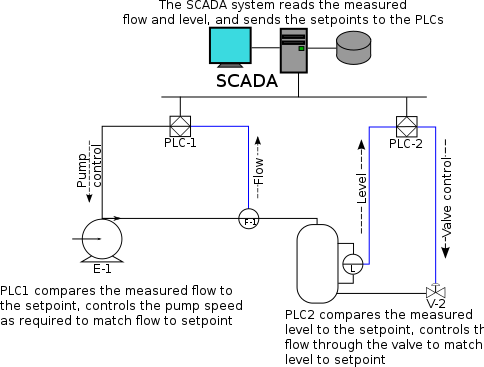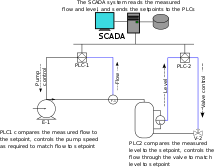
Berikut adalah penjelasan mengenai SCADA dari Wikipedia Bahasa Indonesia. Penjelasannya sedikit lebih singkat dari postingan sebelumnya, namun semoga saja bisa lebih mudah dimengerti oleh pembaca..
SCADA (kependekan dari Supervisory Control And Data Acquisition) adalah sistem kendali industri berbasis komputer yang dipakai untuk pengontrolan suatu proses, seperti:
- proses industri: manufaktur, pabrik, produksi, generator tenaga listrik.
- proses infrastruktur: penjernihan air minum dan distribusinya, pengolahan limbah, pipa gas dan minyak, distribusi tenaga listrik, sistem komunikasi yang kompleks, sistem peringatan dini dan sirine
- proses fasilitas: gedung, bandara, pelabuhan, stasiun ruang angkasa.
Beberapa contoh lain dari sistem SCADA ini banyak dijumpai di lapangan produksi minyak dan gas (Upstream), Jaringan Listrik Tegangan Tinggi dan Tegangan Menengah (Power Transmission and Distribution) dan beberapa aplikasi yang dipakai untuk memonitor dan mengontrol areal produksi yang cukup luas.
Suatu sistem SCADA biasanya terdiri dari:
- antarmuka manusia mesin (Human-Machine Interface)
- unit terminal jarak jauh yang menghubungkan beberapa sensor pengukuran dalam proses-proses di atas
- sistem pengawasan berbasis komputer untuk pengumpul data
- infrastruktur komunikasi yang menghuhungkan unit terminal jarak jauh dengan sistem pengawasan, dan
- PLC atau Programmable Logic Controller
Yang dimaksud dengan Supervisory Control atau Master Terminal Unit (MTU) adalah kendali yang dilakukan di atas kendali lokal atau Remote Terminal Unit (RTU), sebagai ilustrasi, pada suatu ladang minyak dan gas (Oil and Gas Field) ada beberapa sumur minyak (Oil Well) yang berproduksi. Hasil minyak mentah (Crude Oil) dari masing-masing sumur produksi tersebut dikumpulkan di stasium pengumpul atau Gathering Station (GS) di mana proses lanjutan terhadap minyak mentah yang terkumpul tersebut dilakukan. Biasanya pada masing-masing sumur minyak produksi terpasang suatu sistem (RTU) yang memonitor dan mengontrol beberapa kondisi dari sumur minyak produksi tersebut. Kendali lokal dilakukan pada masing-masing production well dan supervisory control yang berada di stasiun pengumpul, melakukan control dan monitoring kepada semua production well yang ada di bawah supervisi. Jika salah satu production well mengalami gangguan, dan stasiun pengumpul tetap harus memberikan dengan production rate tertentu, maka supervisory control akan melakukan koordinasi pada production well lainnya agar jumlah produksi bisa tetap dipertahankan.
Pada umumnya jarak antara RTU dengan MTU cukup jauh sehingga diperlukan media komunikasi antara keduanya. Cara yang paling umum dipakai adalah Komunikasi Radio (Radio Communication) dan Komunikasi Serat Optik (Optical Fiber Communication).
Pada sistem tenaga listrik, media komunikasi yang dipergunakan adalah Power Line Communication, Radio Data, Serat optik dan kabel pilot. Pemilihan media komunikasi sangat bergantung kepada jarak antar site, media yang telah ada dan penting tidaknya suatu titik ( gardu ).
Pengaturan sistem tenaga listrik yang komplek, sangat bergantung kepada SCADA. Tanpa adanya sistem SCADA, sistem tenaga listrik dapat diibaratkan seperti seorang pilot membawa kendaraan tanpa adanya alat instrumen dihadapannya. Pengaturan sistem tenaga listrik dapat dilakukan secara manual ataupun otomatis. Pada pengaturan secara manual, operator mengatur pembebanan pembangkit dengan melihat status peralalatan listrik yang mungkin dioperasikan misalnya Circuit Breaker ( CB ), beban suatu pembangkit, beban trafo, beban suatu transmisi atau kabel dan mengubah pembebanan sesuai dengan frekuensi sitem tenaga listrik. Pengaturan secara otomatis dilakukan dengan aplikasi Automatic Generating Control ( AGC ) atau Load Frequency Control ( LFC ) yang mengatur pembebanan pembangkit berdasar setting yang dihitung terhadap simpangan frekuensi.
Salah satu hal yang penting pada sistem SCADA adalah komunikasi data antara sistem remote ( remote station / RTU ) dengan pusat kendali. Komunikasi pada sistem SCADA mempergunakan protokol khusus, walaupun ada juga protokol umum yang dipergunakan. Protokol yang dipergunakan pada sistem SCADA untuk sistem tenaga listrik diantaranya :
- IEC Standar meliputi IEC 60870-5-101 yang berbasis serial komunikasi dan IEC 60870-5-104 yang berbasis komunikasi ethernet.
- DNP 3.0
- Modbus
- Proprietary solution, misalnya KIM LIPI, HNZ, INDACTIC, PROFIBUS dan lain-lain
--------









